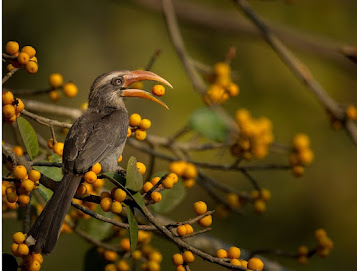A Bird with an orange beak
The pungent, dense figures of smoke from the chimney of a nearby moss-laden, well-camouflaged hut; seeped through the dense canopies of the jungle. The redolence of this waft, reminisced me of the smoldering of the pot tamarind Garcinia gummi-gatta. Tiny, dry soot particles raising from the put off charcoal; interplayed with the humid air, leaving a dirty hue on the walls it contacted. The local men were busy collecting the 'Kaad anabe' (Forest mushrooms) that grew luxuriantly on the leaf litter of the forest floor. These petite, dainty, cream-colored beauties when cooked can remind one of the rustic countryside. The edge trail of the adjacent woods showed some pointy protrusions from the earth. The tips were blanketed with black, leathery leaf-sheaths. These were the miniature propagules of the fastest growing plants known to earth- Bamboo. Chengappa, the care-taker of a nearby coffee estate was chopping these off assiduously with his whetted machete. He turned towards me with a bewitching smile and said "Bamboo shoot curry during monsoon is a match made in heaven" in kodava thak, a dialect of Kodagu. He also told me about the curing of the bamboo and making of recipe, it is one rustic recipe that I have carefully documented in my recipe book.
I sat there beneath a fig tree overlooking the estates. A raucous, strident and cackling echo in the air beckoned me of some life in the tree. Grey-bodied, orange-beaked and a not so very corpulent body of a bird caught my eyes. Its eyelashes were the ones that I sat admiring. It was the Malabar Grey Hornbill, a bird endemic to the south western ghats. With the distinct frenzy of a nearby group rejoicing over their freshly caught mud crabs and the musky odor of incense from a nearby home. I sat there sighing at the monsoon marvels mother nature has bestowed us with, sipping on a small cup of throat soothing concoction made of wild herbs.
Malabar Grey Hornbill feeding on Ficus fruits.
Picture courtesy: Natureinfocus
Know more about the animal:
1. Hornbills are charismatic avians found in the tropical and the sub-tropical regions of the world. They are striking birds with exceptionally colored plumes and curved mandibles, with or without casque. Casque is a mound like structure found above the upper mandible, it is believed to resonate their call through long distances.
2. We have nine species of hornbills in the Indian subcontinent. Great Indian hornbill, Malabar grey hornbill, Malabar pied hornbill, Rufous necked hornbill, Wreathed hornbill, Oriental pied hornbill, Indian grey hornbill, Narcondam hornbill and Austen's brown hornbill. Of which the first three are found in the jungles of the Western ghats.
3. Hornbills are also known as "Gardeners of the Forests" owing to their ability to disperse seeds. They are primarily frugivorous, they consume the fruit of trees. The acid in the stomach is known to naturally scarify the seeds thereby weakening their dormancy. Thus, when regurgitated or defecated the seeds germinate far off from their parent plant.
4. Another, unique quality of hornbills is their loyalty to their partners. They are monogamous and mate with each other for life. They show extreme biparental care in raising the young one. The pregnant mother, seals herself in a tree cavity and depends only on her male partner for food. Post the fledgling stage of the young one, the mother and the young one come out of the cavity.




Well scripted
ReplyDeleteBeautiful bird! Nicely scripted
ReplyDeleteIncredible Narration!
ReplyDeleteSpectacular description!!!
ReplyDeleteLovely
ReplyDeleteWonderful!
ReplyDeleteWonderful.
ReplyDelete